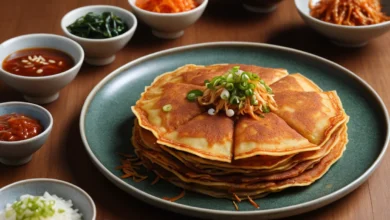The Ultimate Victoria Sponge Cake Recipe: A Timeless Classic with a Perfect Twist

The Victoria sponge cake is a timeless British classic that has graced afternoon tea tables for centuries. Named after Queen Victoria herself, this light, airy cake filled with jam and whipped cream has become an iconic dessert that’s loved by all. But how can you make the perfect Victoria sponge cake that’s both moist and fluffy, with the ideal balance of sweetness? Whether you’re new to baking or looking to elevate your sponge cake game, this guide offers the essential tips, frequently asked questions, and an unbeatable recipe that will ensure your cake turns out perfectly every time.
Why the Victoria Sponge Cake Remains a Favorite
The Victoria sponge is beloved for its simplicity, elegance, and taste. With its golden, buttery sponge layers, sweet raspberry or strawberry jam, and fluffy cream filling, it’s a delightful treat that’s perfect for special occasions or simple gatherings. It’s also highly adaptable; once you master the basics, you can personalize your sponge with different fillings, decorations, or even make it gluten-free or vegan-friendly. Its universal appeal, ease of baking, and light texture make it a go-to recipe for bakers of all skill levels.
Frequently Asked Questions About Victoria Sponge Cake
What Is the Secret to a Fluffy Victoria Sponge?
The key to a light and airy Victoria sponge cake lies in the preparation of the ingredients and the baking technique. Make sure your butter and eggs are at room temperature before starting, as this ensures a smooth and even batter. Creaming the butter and sugar thoroughly until pale and fluffy is another crucial step. This process incorporates air into the mixture, resulting in a lighter cake. Lastly, be careful not to overmix the flour into the batter, as this can result in a dense cake.
Should You Use Self-Raising Flour or Plain Flour?
Traditionally, a Victoria sponge is made with self-raising flour, which already contains a leavening agent like baking powder. This helps the cake rise without the need to add extra leavening. However, if you only have plain flour, you can easily convert it by adding 1 ½ teaspoons of baking powder for every cup of flour used. Just make sure to sift the flour and baking powder together to ensure even distribution.
What Type of Jam Is Best for Victoria Sponge Cake?
Classic Victoria sponge recipes usually call for raspberry or strawberry jam, but the choice of jam ultimately comes down to personal preference. Raspberry jam provides a slight tartness that contrasts beautifully with the sweetness of the cake, while strawberry jam offers a more mellow sweetness. You can also experiment with other flavors like apricot or blackcurrant if you want to add a unique twist to your sponge.
Can You Make a Dairy-Free or Vegan Victoria Sponge?
Yes, you can! A dairy-free Victoria sponge is simple to make by swapping the butter and cream for plant-based alternatives, such as vegan margarine or coconut cream. For a vegan version, you’ll also need to replace the eggs with a substitute like flax eggs, mashed bananas, or applesauce. Just remember that these substitutes may slightly alter the texture and flavor of the cake, so choose the option that works best for your taste and dietary needs.
How Do You Store a Victoria Sponge Cake?
Victoria sponge is best enjoyed fresh, as the cake can dry out over time. However, if you need to store it, wrap the cake layers in cling film and store them in an airtight container at room temperature for up to 2 days. Once filled with cream and jam, the cake should be stored in the refrigerator and consumed within 1-2 days. If you’d like to freeze the sponge layers, do so before filling them and make sure to wrap them tightly in plastic wrap and foil.
Recipe: How to Make the Perfect Victoria Sponge Cake
Ingredients
- 200g self-raising flour
- 200g caster sugar
- 200g unsalted butter, softened
- 4 large eggs, room temperature
- 1 tsp baking powder
- 2 tbsp milk
- 1 tsp vanilla extract
- 4 tbsp raspberry or strawberry jam
- 200ml double cream (or whipped cream)
- Icing sugar for dusting
Instructions
- Preheat the Oven and Prepare Cake Tins:
Preheat your oven to 180°C (160°C fan or 350°F). Grease and line two 20cm (8-inch) round cake tins with parchment paper to prevent sticking. - Cream Butter and Sugar:
In a large mixing bowl, beat the butter and sugar together using an electric mixer until the mixture is pale, light, and fluffy. This should take about 4-5 minutes. Beating the mixture well at this stage is crucial to incorporating air, which gives the sponge its light texture. - Add the Eggs One by One:
Beat in the eggs one at a time, making sure each one is fully incorporated before adding the next. If the mixture starts to curdle, add a tablespoon of flour to help bring it back together. - Sift and Fold in the Flour:
Sift the self-raising flour and baking powder into the bowl. Gently fold the dry ingredients into the batter using a spatula or metal spoon. Be careful not to overmix; you want to retain as much air in the batter as possible. - Add Vanilla and Milk:
Stir in the vanilla extract and milk to loosen the mixture and give the batter a smooth consistency. The batter should drop easily off the spoon when tapped. - Divide and Bake:
Divide the batter evenly between the two cake tins and smooth the tops with a spatula. Bake in the preheated oven for 20-25 minutes, or until a skewer inserted into the center comes out clean and the cakes are golden brown. - Cool the Cakes:
Once baked, remove the cakes from the oven and allow them to cool in their tins for 10 minutes. Then turn them out onto a wire rack to cool completely. - Assemble the Cake:
Once the cakes have cooled, spread the jam evenly over the top of one of the sponges. In a separate bowl, whip the cream until soft peaks form and spread it over the jam layer. Place the second sponge on top and lightly dust with icing sugar to finish. - Serve and Enjoy:
Slice and serve your freshly made Victoria sponge with a hot cup of tea or coffee.
Key Tips for the Perfect Victoria Sponge
- Room Temperature Ingredients: Using room temperature butter and eggs ensures a smoother batter and even baking.
- Weigh Your Ingredients: Precise measurements are key to achieving the perfect balance between the cake’s lightness and structure.
- Don’t Overmix the Batter: Gently fold the flour into the mixture to avoid knocking out the air, which can result in a dense sponge.
- Baking Time: Keep an eye on the cakes as they bake. Overbaking will dry them out, while underbaking will leave the middle raw.
Nutritional Information
Victoria sponge cake is not only a delicious treat but also offers some nutritional value. While it is indulgent, each slice provides a good source of carbohydrates and fats that are necessary for energy. If you’re looking to reduce calories, you can use a lighter whipped cream or opt for a sugar-free jam.
Conclusion
The Victoria sponge cake stands the test of time because of its simplicity, elegance, and irresistible flavor. Whether you’re serving it at a party or enjoying it as an afternoon treat, following the steps above will ensure you have a perfect, light, and fluffy sponge that will wow your guests. The versatility of this cake also makes it an ideal base for experimenting with different flavors and fillings. Now that you have the ultimate recipe and expert tips, it’s time to get baking and impress your friends and family with this quintessentially British classic.





